With Covid still limiting travel outside the European Union, we didn’t want to give up our tradition of visiting a more distant destination in 2021. We had originally booked a trip to Tanzania for February, drawn by the idea of an African safari. Unfortunately, Covid had other plans. Our flights were cancelled at the end of January, and France went into a stricter lockdown in February. Instead of spending the school holidays in Africa, we were stuck at home.
Not ready to abandon the idea of Tanzania, we decided to postpone the trip to the October school holidays rather than cancelling completely. We did have to adjust flights several times, and the best solution turned out to be flying from Barcelona with Qatar Airways. Barcelona is about a six-hour drive from Antibes, so we left a day early and stayed overnight in a hotel near Barcelona-El Prat Airport.
On the morning of Saturday, October 23rd, we went for our pre-booked PCR tests in Antibes—required for entry into Tanzania regardless of vaccination status—before loading the car and heading straight for Barcelona. By lunchtime on the motorway, we had received our negative results and finally felt that the holiday could truly begin. Our hotel, B&B Hotel Barcelona Viladecans, was conveniently located in a shopping district just a couple of kilometres from the airport.
The next morning, we drove our car to ParkVia parking near the airport and took the shuttle to the terminal. Two weeks’ parking for 65 euros seemed reasonable. Qatar Airways, like most airlines these days, carried out a thorough check of all documents before allowing anyone to reach the luggage drop desk—PCR tests (dates double-checked) and the Tanzania health form QR codes were carefully verified. While we had no problems, we saw many travellers experiencing delays, so arriving early is essential. Once through all the checks, we had just enough time for a quick breakfast in the airport’s lovely outdoor courtyard with cafes and restaurants.
Qatar Airways’ reputation for excellent service held true. The six-hour flight to Doha passed quickly with movies on the in-flight entertainment system, a glass of wine, and a surprisingly good vegetarian meal.
Ready to go
We had an eight-hour layover in Doha, and despite the complications of travelling during Covid, we decided to leave the airport for a quick look at the city. Before we could even think about stepping outside, there was quite a bit of prep. While still in France, I had to fill out forms on the Qatar government website, uploading passport copies, PCR results, and other documents. About half an hour later, I received confirmation by email. Next, we had to download the Etheraz app onto our phones.
Once through passport control in Doha—with photos and fingerprints taken—we had to purchase a Qatari SIM card inside the customs area to activate the app. The activation required using the visa number from our passport stamp, and once it was complete, a green QR code appeared on the app, allowing us to finally leave the airport. The whole process took about an hour and a half. Covid has certainly made even simple tasks like passport control far more complicated. Fortunately, only adults were required to use the app; the kids were free to pass through without it.
We took the subway from the airport to the city centre. It was quick, clean, and cheap—but unfortunately, Doha didn’t quite impress us. Perhaps it was because we arrived at 7:30 p.m., or maybe it was the endless construction sites that made the city feel confusing. Google Maps repeatedly directed us to streets that were closed due to building work. On the positive side, the skyscrapers were beautifully lit up at night.
We walked around for nearly two and a half hours in 30°C heat before finally stopping at a mall. There, we bought sushi and Krispy Kreme doughnuts, which we enjoyed as an impromptu night-time picnic in a park just outside the mall. By 10:30 p.m., we all agreed it was time to head back to the airport, even though our flight to Kilimanjaro was scheduled to depart at 1:40 a.m.
Mainland Tanzania - Arusha and around and the national parks of Tarangire, Serengeti and Ngorongoro
The flight from Doha to Kilimanjaro took around five hours, and since it was a night flight, we all managed to catch some sleep. One of the great things about travelling to Tanzania is that jet lag isn’t an issue—the time difference with France is just one hour. Africa greeted us with stunning views of Mount Kilimanjaro at sunrise, a truly unforgettable welcome.
We landed at Kilimanjaro Airport at 7:40 a.m., but it took over an hour to actually leave. First, every passenger had to go through a health check—PCR tests were carefully verified, temperatures were taken, and travellers from high-risk countries (UK, US, China, etc.) were sent for additional antigen testing. Then came the visa process: filling out applications, queuing for approval, paying the $50 USD fee per person, and finally getting passports stamped. After collecting our luggage and passing through one final security check, we were ready to go. I also took a moment to exchange some local currency at the airport—one euro was roughly 2,400 Tanzanian shillings.
Our safari company owners, Ene and Emanuel from Siafu, were waiting to pick us up. I had done extensive research before booking the safari and found Siafu to be the most trustworthy company, perhaps partly because one of the owners is Estonian, like me. Ene had always responded promptly and warmly to my emails, and the team was flexible when we had to postpone the trip from February to October.
For our first night, we stayed at a hostel in the lush countryside about 15 kilometres outside Arusha. Banana Farm Eco Hostel was a wonderful introduction to Tanzania, and we wished we could have spent more time there. The hostel is a working farm with seven rooms (and a few more under construction) and uses many of its own farm products to feed guests. We stayed in the family room, which was simple but comfortable, with a double bed, a bunk bed, an en suite bathroom, and a very reasonable rate of $30 USD per night with breakfast included.
The highlight of Banana Farm was its beautiful courtyard, filled with hammocks, tables, and benches for guests to relax and socialize. Fresh bananas were always available for everyone, and the peels had to be given for the farm’s cows. It was a perfect first night in Tanzania—peaceful, green, and full of local charm.
Banana Farm Eco Hostel also offers a free farm tour for guests who want to learn about life on the farm. The tour lasts about two hours and is fascinating. We learned about the different types of bananas, coffee plants, avocado trees, and the vegetable garden, as well as how they produce biogas from cow dung and organic waste to use for cooking. The tour also takes you around the farm’s grounds, with stunning views of Mount Meru in the background.
Papayas
Mount Meru
Breakfast the next morning was equally memorable, with freshly baked bread, samosas, pancakes, and fruit picked straight from the farm. Their coffee, made from beans grown on-site, was rich and fragrant—one of the best cups we had during our trip. Banana Farm felt like a real home away from home, and it was the perfect introduction to rural Tanzania.
The next morning, Emanuel from Siafu Safaris picked us up from Banana Farm and drove us to our accommodation in Arusha. Before dropping us off at the hotel, he gave us a brief drive-through tour of the city, pointing out the main sights. Arusha is an important international hub, hosting the East African Community and serving as the capital of the East African Federation.
Our accommodation, Hotel Tulia, and all transfers were arranged by Siafu Safaris. The hotel was clean, comfortable, and staffed with friendly people, making it a welcoming base for our few days in Arusha. Even so, we had another meaningful and eventful day ahead before our safari officially began.
When we first knew we were going to Africa, we wanted to do something to help local children. A bit of online research led us to a small charity called the Maria Carpio Foundation. The foundation runs a school for children of Maasai widows and welcomes any form of support. Through WhatsApp, we connected with Maria, who put us in touch with Mibaku, a local Maasai coordinator managing the school in Tanzania.
Back home, our kids spoke about the project at school with their wonderful pastoral teacher, Mme Gassi. With her help, a small collection of school supplies was organized for the Maasai children. The response was amazing—so many people wanted to help that we ended up with two extra suitcases, around 40 kilograms of school supplies, which we were thrilled to bring with us to donate in person.
Mibaku and the head teacher of the school picked us up from the hotel, and we set off for Eretore School, about an hour’s drive from Arusha. On the way, we made a quick stop at the local market to buy some rice for the school lunches—a small contribution that would go a long way for the children.
The school is located on Maasai land, and many of the kids have to walk long distances from a very young age just to attend class. When we arrived, we were greeted with a heartwarming surprise: a little welcome ceremony organized by the school. The children lined up to welcome us and sang a cheerful song, their smiles and voices filling the air.
We had the chance to meet the school staff and visit the classrooms, and it was immediately clear that the supplies we had brought would be put to good use. Seeing the children’s excitement and the school’s lively atmosphere made all the planning and effort worth it—it was a touching reminder of the impact a small gesture can have.
During the drive to the school and back to Arusha, we had a fascinating conversation with Mibaku, who is Maasai himself. He shared insights into the life of the Maasai people—their culture, customs, and traditions—which made our visit to the school even more meaningful.
In the afternoon, we explored Arusha on foot, stopping by the local Maasai Market for some souvenir shopping before heading to a pleasant Chinese restaurant called Peace for dinner. Arusha is Tanzania’s third-largest city, with a population of nearly one million. It’s often called the “Safari Capital” of Tanzania, as most northern safaris start and end here.
The next morning, we had an early start. Our safari guide, Francis, was picking us up at 8 a.m., and we needed to have breakfast beforehand. We were able to leave a suitcase of items we didn’t need during the safari at the hotel, which we would return to afterward. Francis made a great first impression—friendly, professional, and clearly knowledgeable. He would be our guide and driver for the next four days.
Our safari vehicle was a comfortable modified Toyota Land Cruiser—the standard choice in the parks. The back had six cushioned seats with pockets for water bottles (which were provided by the safari organizers) and even an electric socket for charging phones. The roof opens, so we kept it closed while driving long distances but popped it open during game drives for an unobstructed view of the wildlife and landscape. It was the perfect setup for the next step of our African adventure to begin.
Our first destination was Tarangire National Park, about a two-and-a-half-hour drive from Arusha. The park takes its name from the Tarangire River, which winds its way through the landscape. While it is one of Tanzania’s smaller national parks at 2,850 km², it is famous for its large elephant herds and the iconic baobab trees that dot the savannah, creating the classic African scenery.
We barely had time to drive in the park before spotting our first wildlife. Even in that short stretch after entering the park, every zebra, wildebeest, gazelle, and impala we passed felt like a reason to stop. At that moment, we had no idea just how many animals we would see over the next few days—each encounter only added to the growing excitement of our safari.
For the evening, we drove about two hours to our accommodation, Fanaka Lodge, in the town of Mto Wa Mbtu. The lodge is conveniently located near Lake Manyara, roughly halfway between Tarangire and Serengeti National Parks. Fanaka is a fairly large property, offering both bedrooms and a campground for tents. Our family room was simple but comfortable, with three double beds, a shower, and a toilet—perfect for a restful night after an exciting day.
Dinner at the lodge’s restaurant was satisfying and delicious. We started with a warming soup, followed by a small buffet of rice with vegetables, meat, and fish sourced from nearby Lake Manyara, served as a flavourful curry. It was the perfect way to end our first day on safari, full of wildlife sightings and the quiet thrill of being immersed in Africa’s natural beauty.
The next morning, after a hearty breakfast, we set off toward the Serengeti. The drive offered breathtaking views of Lake Manyara, with its shimmering waters framed by lush greenery. Along the way, we made a few stops to buy local souvenirs from Maasai artisans, their colorful beads and handcrafted items making perfect keepsakes.
As we approached the Serengeti, we passed several Maasai villages along the road. Curious to learn more about their way of life, we asked our guide, Francis, if it would be possible to visit one. We turned off the main road and stopped near a village. Francis spoke with one of the villagers—later introduced to us as Paul, the son of the village chief—and we were welcomed to visit with a small contribution toward water and school supplies for the children.
The Serengeti ecosystem is not only vast but also one of the oldest and most scientifically significant on the planet. Its unique climatic patterns, flora, and fauna have remained virtually unchanged for over a million years, a testament to the careful stewardship of the Maasai communities who have lived alongside the wildlife for generations. Today, the park is home to more than 500 species of birds—including the striking secretary bird and ostrich—over two million wildebeests, 300,000 gazelles, 200,000 zebras, and 100,000 buffaloes.
Driving through the park, the landscape was breathtaking. The endless plains stretched in every direction, dotted with grazing zebras, wildebeest, impalas, and gazelles. Here and there, giraffes and elephants wandered gracefully, while lush riversides were alive with hippos and flocks of colorful birds.
Of course, we were on the lookout for the big cats—and we were not disappointed. We spotted several prides of lions lounging in the grass, a leopard casually crossing the road in front of our car, and two cheetahs on the hunt, catching a young gazelle just a short distance away. One particularly dramatic moment was witnessing an eagle swoop down and snatch a baby gazelle. Each sighting was made even richer by our knowledgeable guide, who shared fascinating stories about the animals, their habits, and their intricate way of life. With every turn of the trail, the Serengeti revealed its magic—and it felt like being part of something truly timeless.

The camp also had a main tent serving as a restaurant and bar, and because the property was small, the service felt exceptionally friendly and personal. As the sun began to set, we climbed a little hill just behind the camp to admire the golden African sunset before sitting down to a delicious three-course dinner. Later, the staff lit a campfire outside, and we gathered around to share stories and chat with the only other guests—a lovely couple also staying at the camp.
Night in the Serengeti is a whole other world. We were only allowed to move around with a security person, as wild animals roam freely. Just outside our tent, a couple of buffalos grazed, and in the distance we saw a civet cat while hearing the haunting calls of hyenas and lions echoing through the darkness. It was both thrilling and humbling to be so close to the raw beauty of the African wilderness.
At 2,300 meters above sea level, the Ngorongoro Crater rim can get quite cool in the mornings and evenings, around 13–14°C. Our room even had a small fireplace, and while we were having dinner, someone had lit the fire to keep us warm at night. And speaking of food—both dinner and breakfast were absolutely delicious. We had brought along some snacks from France, just in case the kids got hungry during the day, but most of it went untouched—the meals provided during the safari were more than sufficient, fresh, and safe to eat.
The Ngorongoro Crater is a wildlife paradise, with an incredible range of habitats: steep forested walls, the alkaline and seasonal salt Lake Magadi, swamps, Lerai Forest, and expansive grasslands. With around 300 species of animals and 500 species of birds, it’s perfect for spotting a vast array of wildlife, including the Big Five. We had already seen four of the Big Five during our safari, with only the rhino missing—until now. Thanks to our guide’s keen eye, we managed to spot two rhinos. They were too far for photos, but with binoculars we could observe them perfectly in their natural habitat—a truly magical moment.
The next morning, it was an early start. Our flight to Zanzibar was scheduled for 9:30 a.m. from Kilimanjaro Airport, about an hour’s drive from Arusha. Emanuel from Siafu Safaris kindly gave us a lift, and although we were a bit sad to leave the spectacular nature and the incredible people of Northern Tanzania behind, we were also buzzing with excitement to explore Zanzibar and enjoy some downtime by the pool or on the beach.
Kilimanjaro Airport is small and easy to navigate, so we arrived well in advance. We were flying with Kenyan airline Precision Air, with Zanzibar as the first stop on the route; after dropping us off, the plane continued on to Dar es Salaam with the remaining passengers. The flight to Zanzibar was just under an hour, giving us enough time to catch glimpses of the lush landscapes below and feel the anticipation of the next chapter of our journey.
Zanzibar
It’s a common misconception that Zanzibar is just one island. In reality, it’s an archipelago in the Indian Ocean, off the coast of East Africa, consisting of several smaller islands and two main ones: Unguja (often referred to simply as Zanzibar) and Pemba. The total population of Zanzibar is around 1.3 million people.
Our stay in Zanzibar was designed to be a relaxing escape, so I had arranged for a local guide, Wadiame, ahead of time from France. He came highly recommended on a travel forum, and we coordinated all our plans with him via WhatsApp. Wadiame was a friendly, professional young man starting his own tour agency, and his rates were very reasonable. He met us at the airport as we exited and drove us in a comfortable six-seater, air-conditioned car for all our transfers and excursions during our stay.
For our four-night stay, I had booked a beach resort in the northeastern part of the island, in the small village of Kiwengwa. The resort, Kiwengwa Beach Resort, was right on the beach and we opted for a half-board package, which made it easy to relax without worrying about finding dinner each evening. The resort was only half full, so it never felt crowded. There were three swimming pools: a crab-shaped saltwater pool just outside our rooms, where we often had the water to ourselves, and a main freshwater pool that hosted entertainment and games throughout the day.
The resort restaurant served breakfast and dinner buffet-style, with themed dinners each evening—African feast, barbecue, Italian, and more. To start our stay off in pure relaxation mode, we tried the spa on the first day, enjoying a Turkish bath and a massage. Johnny loved the massage so much that he returned for another session later in our stay. After the long days spent in safari vehicles, it was the perfect way to unwind and transition into pure vacation mode.
Although the hotel was wonderful and the beach absolutely stunning, we’re not the type of travelers who can spend days lounging by the pool doing nothing. So, the next morning, we set off to explore one of Zanzibar’s most famous attractions: a spice plantation. Wadi picked us up at the hotel, and the drive took about 45 minutes through the island’s lush countryside.
At the plantation, a local guide was waiting to take us around the extensive grounds, explaining the many plants grown there and their uses. Some we recognized from previous travels, but others were new to us—like cardamom and clove. We also visited a local women’s cooperative on the plantation, where soaps are made from essential oils and coconut fat. We bought some to take home, happy to support the local artisans.
No visit to Zanzibar is complete without exploring its coral reefs and discovering the vibrant underwater world surrounding the island. One of the most famous areas is the Mnemba Island Conservation area. Wadi picked us up early in the morning for two reasons: it was low tide, allowing us to visit a tiny sand islet normally submerged, and the morning hours offered the best chance to spot dolphins nearby.
We arrived at the mainland beach near Mnemba Island and walked a couple of hundred meters across shallow water to reach the boat—the tide was very low. Our first stop was the tiny islet, which would be completely underwater in less than an hour as the tide rose. It was breathtaking—soft, white sand surrounded by the bluest water we had ever seen. From there, Mnemba Island was clearly visible, but the island itself is off-limits unless you’re staying at the exclusive five-star resort that occupies it entirely.
Our boat
Our final stop was at the edge of a coral reef, where the water was shallower and perfect for snorkeling. The underwater world was stunning—vivid fish, intricate corals, sea urchins, and starfish everywhere. The boat supplied all snorkeling gear, making it easy to dive right in. When we finished, Wadi had prepared a generous tray of fresh fruit as a snack, which we enjoyed while floating on the calm water.
By the time we returned to the beach, the tide had already risen, shortening the walk back to the car. It was a morning full of unforgettable experiences, combining the thrill of wildlife encounters with the serene beauty of Zanzibar’s crystal-clear waters.
After a packed day, we decided to take it slow and keep the next day free of plans. But Johnny and I couldn’t resist an early start—we headed to the beach just outside the hotel to catch the sunrise. At around 6 a.m., the sky was painted in soft pinks and oranges, and the beach was almost completely empty. It felt like we had the whole world to ourselves.
After soaking in the morning calm, we grabbed some coffee from the hotel’s breakfast buffet and sipped it in the quiet lobby bar, watching the day slowly wake up. With the tide unusually low, we spent the next hour wandering along the seabed, searching for tiny starfish hidden among the sand and shallow pools.
Just before sunrise
Dinner that evening was an Italian feast at the buffet, which the kids absolutely devoured. The evening didn’t end there—a Michael Jackson-themed show followed, complete with talented dancers and a high-energy performance that had everyone clapping along. It was the perfect way to close our stay at Kiwengwa Beach Resort.
The next day, we still had almost a full day before heading to the airport, and we decided to spend it exploring Stone Town. Many people assume Stone Town is the capital of Zanzibar, but actually, the capital is Zanzibar City—Stone Town is just its historic heart. Wandering through its narrow, winding streets, you’ll find a fascinating mix of architecture shaped by centuries of Omani, Portuguese, Indian, and British influence. It’s bustling, a little chaotic, but endlessly intriguing.
To make the most of our limited time, Wadi had arranged a guide to show us around the main sites. Navigating Stone Town on our own would have been a nearly impossible mission in the short time we had, but with a guide, the city’s secrets and stories came to life.
No visit to Stone Town is complete without seeing the Old Fort. Its history tells the story of Zanzibar in a nutshell. Originally built by the Portuguese in the 17th century and later rebuilt by the Omanis in the 18th century, the Old Fort is one of Stone Town’s oldest buildings. Entrance is free, and the inner courtyard often hosts cultural festivals and events, making it a living part of the city rather than just a historical site.
To wrap up our tour of Stone Town, we stopped for a meal at Lukmaan Restaurant, a simple but extremely popular local eatery. The menu offers a wide variety of Zanzibari dishes, and the fresh fruit smoothies were a perfect way to cool down after a morning of sightseeing.
Our journey home began at Zanzibar Airport. Our first flight took us to Doha, where we had just over an hour before connecting to Barcelona. Luckily, the flight from Doha to Barcelona wasn’t full, so we could stretch out and get some much-needed rest. Stepping off the plane in Barcelona, the early morning chill of 8°C was a sharp contrast to the warm, tropical mornings we had enjoyed in Zanzibar. From there, it was a long six-hour drive back to Antibes, but finally, we were home.
Tanzania is a truly amazing country, offering a mix of incredible nature, wildlife, and the idyllic beaches of Zanzibar. The safari experience is once-in-a-lifetime—seeing animals up close and sleeping in a tent in the middle of the Serengeti is unforgettable. I hope that one day we’ll return to Tanzania—if not for a safari, then at least to soak up the sun on Zanzibar’s stunning beaches.















































































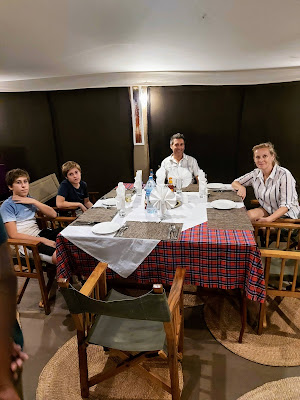






























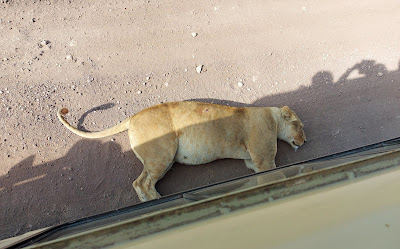


















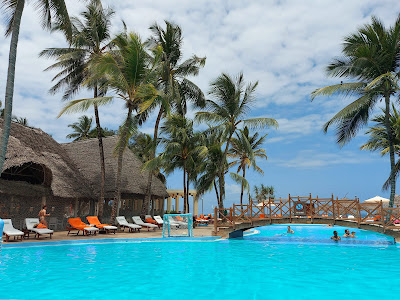










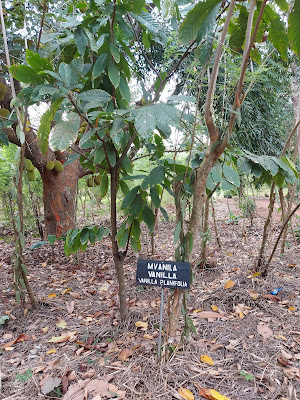

























































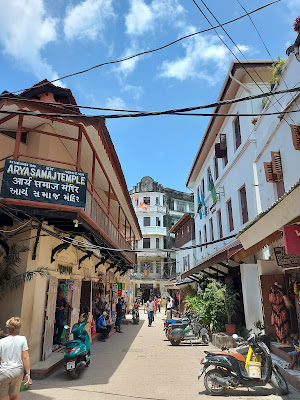








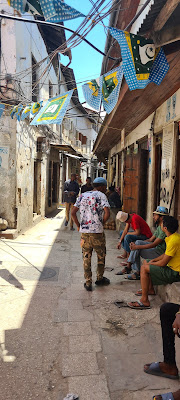





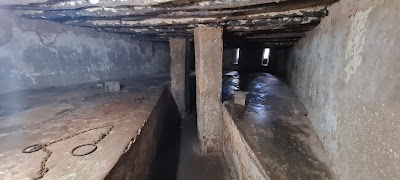





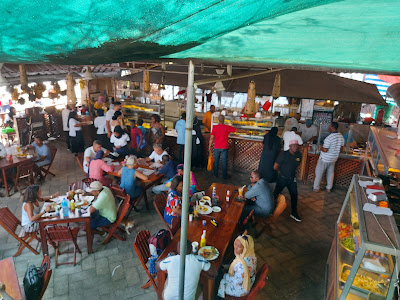






No comments:
Post a Comment